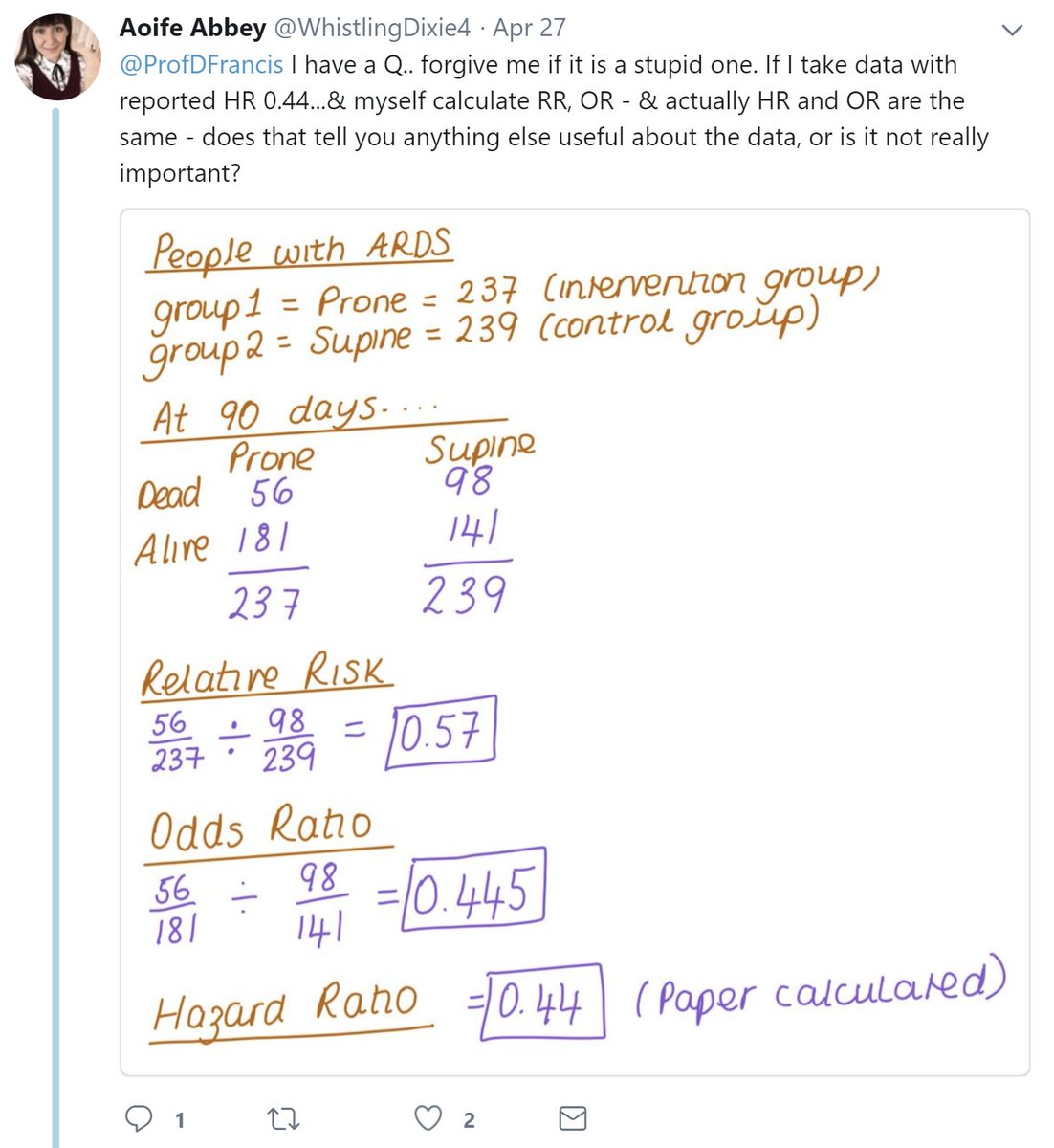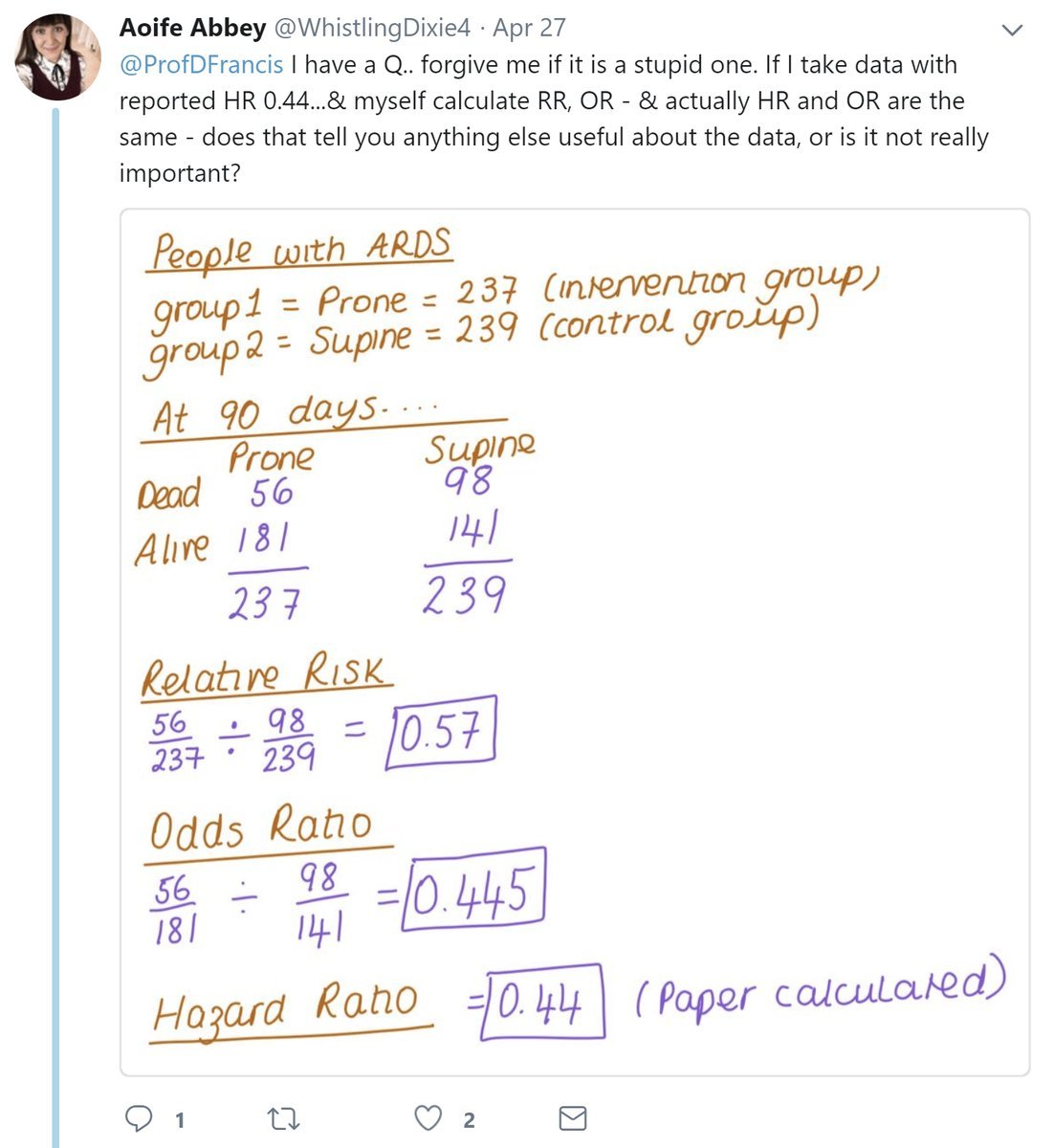Note that the questionner has puffed himself up to the full 24 atmospheres of hot air.
Stop whining. I haven't mentioned anyone by name. Nobody knows who I am talking about, unless they look at the image and deduce it somehow. I didn't type in any name, or an anagram thereof, so leave me alone.
So we can only do Odds, Risk, and their ratios.
I have a certain rate of complications.
Rasha's is HALF mine.
(Obviously this is only a thought experiment, and I am actually MUCH better than her at everything, because I am a professor etc).
So every day they need a procedure to rejiggle the leads back into some sort of cardiac chamber, rather than the liver.
That day, 10% of Rasha's are bleeding-free.
What is my freedom-from-bleeding rate (let's call it "doing fine" rate)?
All their leads get displaced.
Everyone gets another procedure next day.
Their probability of escaping bleeding today is also 0.80.
What is the probability of my patients being bleeding free TONIGHT?
Hint. They need to escape bleeding at both procedures, 0.80 x 0.80
What is the probability of still being bleeding free after both days?
What was the hazard ratio on the SECOND day?
In other words, what was the INSTANTANEOUS risk for Rasha's patients, divided by that of my patients?
By instantaneous I mean look at each day in isolation.
So Hazard Ratio for Rasha-versus-Darrel will be the same on the two days.
Her hazard ratio is 0.5.
Always.
Every day.
From here to eternity.
Let's see what happens to RISK ratio, shall we?
At 1 day, risk ratio is 0.1/0.2, which is what?
At two days, 0.81 of Rasha's patients are doing fine, but only 0.64 of mine are.
So her RISK ratio is one-minus-that, i.e.
0.19/0.36
Is this more than 0.5, less than 0.5, or exactly 0.5?
Try it for yourself if you don't believe me. It's 0.5277.
After another day it is this:
lmgtfy.com/?q=(1-.9%5E3)%…)
As the days go by, her risk ratio, having started at 0.5, gradually inches up.
By 10 days of repeated operations, the risk ratio under Rasha is 0.73.
Try the numbers and see!
Shown here graphically for 20 days.
X axis is NUMBER OF DAYS of procedures done per patient.
Y axis is RISK RATIO, Rasha - versus - Darrel
lmgtfy.com/?q=plot+(1-0.9…
=================
If you are a better operator than the other guy, you may be able to show it after one "round" of procedures. But as time goes on and people have more and more procedures sequentially, the RISK RATIO will tend towards 1.
If you are the other guy, i.e. YOUR risk ratio is >1, e.g. 2, then this works in your favour.
Ask for multiple rolls of the die. Your initial "2" risk ratio will dwindle with time and tend towards 1, given enough goes.
\___________________________/
After first day,
odds for Rasha is 0.1/0.9=1/9
odds for me is 0.2/0.8 = 1/4
The Odds Ratio for Rasha versus me is
Odds for Rasha is 0.19/0.81 = 0.2345...
Odds for me is 0.36/0.64 = 0.5625
Odds ratio Ratio for Rasha versus me, at the end of the second day, is:
Her Odds Ratio starts near 0.5, but progressively moves away from it with time.
Here is the graph. Again, the x axis is the number of days (i.e pacemaker procedures) each patient has had.
google.co.uk/search?rlz=1C1…
Risk ratio goes TOWARDS 1, as you repeatedly do the thing.
Odds ratio goes AWAY from 1, as you repeatedly do the thing.
The only thing that stays 0.5, is the hazard ratio.
But to calculate that you need the DATES of events (or, equivalently, the shape of the hazard func.)
Risk Ratio
Hazard Ratio
Odds Ratio
on a single graph.
Here we go! Read and weep. Only hazard ratio can stay constant.
wolframalpha.com/input/?i=plot+…
HAZARD ratio is the ideal measure. However, to calculate it, requires the DATES of events. The authors may be able to do, but general readers of a paper (or meta analysts) can't.
ODDS ratio diverges away from 1 with time
.
RISK ratio converges towards 1.
Closing down for the night but please feel free to ask Qs.
The key to them being roughly the same is that fewish events had happened (not specifically how many days had passed) but I guess you realise that.
we are all dead,
All our efforts have
a risk ratio of 1, and
an odds ratio of infinity*."
Albert Einstein
J Almost True Statements 2018.
Odds ratios greater than 1 trend upwards towards infinity , while odds ratios smaller than 1 trend towards 0.
Warning. I don't actually know if this is true. It's a bit of a gut instinct guess. Happy to be corrected by an actual statistician etc.











